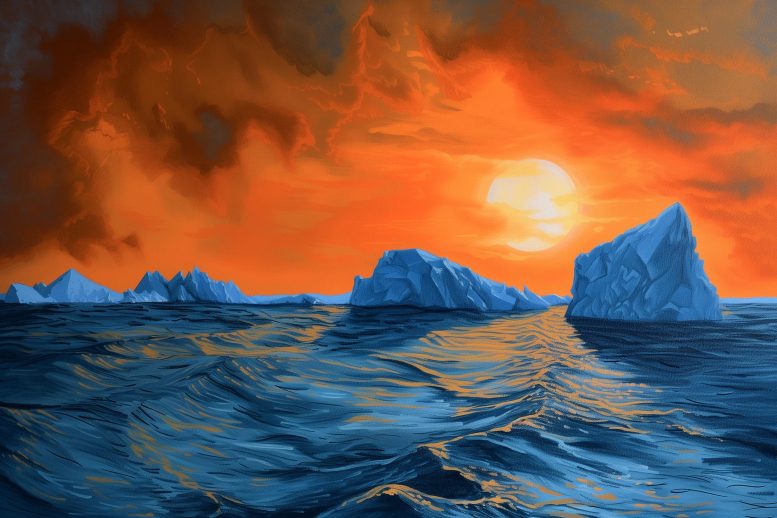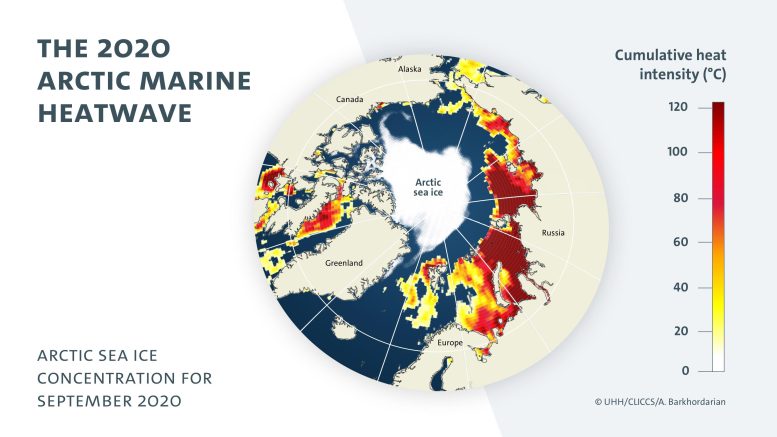
Recent studies reveal a significant increase in marine heatwaves in the Arctic Ocean, with temperatures rising above average and thinning ice leading to a new Arctic phase. Human-induced greenhouse gases are a major contributing factor, threatening the region’s ecosystem. Credit: SciTechDaily.com
Marine heatwaves will become a regular occurrence in the Arctic in the near future and are a product of higher anthropogenic greenhouse-gas emissions – as shown in a study just released by Dr. Armineh Barkhordarian from Universität Hamburg’s Cluster of Excellence for climate research CLICCS.
Since 2007, conditions in the Arctic have shifted, as confirmed by data published today (February 13) in the journal Nature Communications Earth & Environment. Between 2007 and 2021, the marginal zones of the Arctic Ocean experienced 11 marine heatwaves, producing an average temperature rise of 2.2 degrees Celsius above seasonal norm and lasting an average of 37 days. Since 2015, there have been Arctic marine heatwaves every year.
The most powerful heatwave to date in the Arctic Ocean was in 2020; it continued for 103 days, with peak temperature intensity that was four degrees Celsius over the long-term average. The probability of such a heatwave occurring without the influence of anthropogenic greenhouse gases is less than one percent, as calculated by Barkhordarian’s team at the Cluster of Excellence CLICCS. By doing so, they have narrowed down the number of plausible climate scenarios in the Arctic. According to the study, annual marine heat waves will be the norm.

The figure shows the most powerful heatwave in the Arctic Ocean to date in 2020, which continued for 103 days. The cumulative heat intensity sums up the daily anomalies in water temperature recorded over the duration of the heat wave in degrees Celsius. Credit: UHH/CLICCS/A. Barkhordarian
The Arctic entered a new phase
In the study, Barkhordarian also proves for the first time that heat waves are produced when sea ice melts early and rapidly after the winter. When this happens, considerable heat energy can accumulate in the water by the time maximum solar radiation is reached in July.
“In 2007, a new phase began in the Arctic,” says Barkhordarian, an expert on climate statistics. “There is less and less of the thicker, several-year-old ice, while the percentage of thin, seasonal ice is consistently increasing.” However, the thin ice is less durable and melts more quickly, allowing incoming solar radiation to warm the water’s surface.
Officially, it is considered to be a marine heatwave when temperatures at the water’s surface are higher than 95 percent of the values from the past 30 years for at least five consecutive days.
“Not just the constant loss of sea ice but also warmer waters can have dramatic negative effects on the Arctic ecosystem,” says Barkhordarian. Food chains could collapse, fish stocks could be reduced, and overall biodiversity could decline.
Are human beings responsible?
Attribution research allows us to compare how the world would have developed without human influences. For the study at hand, the calculations focused on the probability of each heatwave occurring in a world without anthropogenic greenhouse gases. In addition, Barkhordarian and her team reviewed satellite data and drew on coupled climate models for their analyses.
Reference: “Arctic marine heatwaves forced by greenhouse gases and triggered by abrupt sea-ice melt” by Armineh Barkhordarian, David M. Nielsen, Dirk Olonscheck and Johanna Baehr, 13 February 2024, Communications Earth & Environment.
DOI: 10.1038/s43247-024-01215-y









“… Barkhordarian also proves for the first time …”
“Proves” is a strong claim, which prudent scientists use sparingly. She may have demonstrated an apparent recent correlation, but that is not proof of a universal relationship.
“The most powerful heatwave to date in the Arctic Ocean was in 2020; …”
Yet, that was the year that COVID shutdowns resulted in a decline in anthropogenic CO2 emissions of as much as 14-18% (April) during the Spring, seasonal ramp-up phase, and an average decline of 6-10% for the whole year. What’s wrong with this picture? Might there be something else that is responsible?
“However, the thin ice is less durable and melts more quickly, allowing incoming solar radiation to warm the water’s surface.”
One hears this claim frequently. However, the impact is overstated. My suspicion is that those making the claim are neither familiar with the geometry of solar illumination or how specular reflection off water behaves. Has she obtained evidence to allow ruling out the ice melting from the bottom up?
https://wattsupwiththat.com/2016/09/12/why-albedo-is-the-wrong-measure-of-reflectivity-for-modeling-climate/
On “Proves”, the vocabulary shift in science is another trend. I see more use of layman’s phrases, like “theory” for “hypothesis”, or “proves” for “demonstrates”, or especially using “truth” or “fact” for a currently accepted theory. Despite effort I’m as guilty as most people, but it shouldn’t be in proper research. The University of Hamburg weakens the research by overstating it; this study didn’t just prove Heatwave Theorem.
I took a look at the study. It operates in probabilities, so there is no “proving”. That said, the whole article wildly mischaracterizes the conclusion. So, I’ll just quote it:
“In summary, while for extreme events in the current climate, such as those in 2007, 2012, and 2020, the presence of GHG (GreenHouse Gas) forcing is necessary (PN = 1.0), it is not sufficient (PS is small). This means that GHG forcing must be present (with ≥99% probability) for such events to happen, but the inclusion of GHG forcing alone is not enough to guarantee the event’s occurrence. However, for moderate events, with an intensity in the range of 0.5–1 °C, GHG forcing emerges as a sufficient cause (with 66–99% probability). This implies that if GHG forcing continues to rise, events with moderate intensity will consistently recur.”
So this study says the marine heatwaves do require an atmosphere, and the makeup of the gasses in the atmosphere are very probably necessary to create the heatwave. Also that the chances of anthropogenic greenhouse gas emissions actually being sufficient to potentially create a marine heatwave only begin to appear between the range of +0.5c and +1c and are somewhere between very probable and little better than random chance. Great. For emphasis, the article found anthropogenic greenhouse gas emission “is not sufficient” to cause a marine heatwave. I would hope the next obvious step would be to look for what variable or variables actually are sufficient. Your 2020 example would be the perfect place to start, with unusually low CO2 emissions versus “The most powerful heatwave to date in the Arctic Ocean was in 2020”, but this article makes up “Marine heatwaves…are a product of higher anthropogenic greenhouse-gas emissions”. Oh well.
Thank you commentators for your on-going clarifications.
Suggest this and other articles published on, or connected to, “climate-science” (at least four in this FEB 13 copy) all need to continue to be called out as obvious pseudoscience – based on comments by more learned commentators (as above).
Where is the promise/assertion: ” SciTechDaily: Home of the best science and technology news since 1998. ” ?
Where are the alternate more balanced scientific articles?
PS: Another suggestion;
perhaps a disclaimer template (to be inserted into the “Leave a comment”) needs to be available which points out, maybe something along the lines/waffle of:
” …This paper relies heavily on pseudoscience and the authors take no responsibility for any testing of the veracity of any personal comments/conclusions herein …” ?